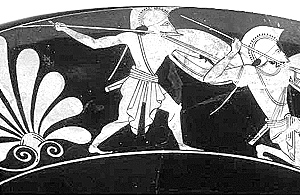 When did the bow and sling become less
honorable than the spear? When did the
Hellenes fill their front lines with spearman?
When did the Hellenes cease to carry a javelin as
well as the thrusting spear? The transition from
fighting in mass with a mix of weaponry to
fighting in phalanx with a standard panoply of
arms and armor may have occurred in a span as
short as 25 years or as long as 75 years.
When did the bow and sling become less
honorable than the spear? When did the
Hellenes fill their front lines with spearman?
When did the Hellenes cease to carry a javelin as
well as the thrusting spear? The transition from
fighting in mass with a mix of weaponry to
fighting in phalanx with a standard panoply of
arms and armor may have occurred in a span as
short as 25 years or as long as 75 years.
Scholars are arguing the timing and details of that changeover. By 650 BC, for sure and probably earlier for some states, the transition was accomplished.
Why the change? Probably to minimize the damage of war so that conflict could be resolved quickly, through a single clash of arms by those individuals most concerned for the stability of their agricultural society. While honor and the concerns of war dominated much of their worldview and expression, most Hellenic farmers were not warmongers.
Whatever the exact sequence, Hellenic warfare became primarily a clash between heavily armed spearmen. The panoply and formation afforded the individual great protection while enabling the whole body of fighters to be formidable in attack.
These were their tools:
- Strong, long spear - iron
leaf blade, 7 to 9 foot ash shaft, and bronze
spike at the butt end
Large, round shield, the hoplon a concave wooden core, three feet across, sheathed in bronze, with an interior arm band and hand grip, with a lip on its rim to permit the heavy shield to rest on the shoulder.
Bronze helmet with cheek guards bronze helm, with a leather, felt, or linen liner, enclosing skull and much of the face. If worn by an officer, the helmet may be crested in any of a number of ways. Helmet styles vary the extent of facial protection and consequent physical and sensory limitation. The Korinthian style is most popular down to the 400's but is eventually superseded by the Thracian style.
Cuirass covering the chest and back - originally the heavy bronze bell cuirass, it evolved into the muscled cuirass as new techniques in bronze permitted lighter construction (500's BC). For most warriors, the bronze cuirass gave way to linen, often reinforced with bronze scales or plates.
Greaves protecting the lower legs covering the knee and shin, a greave protected the front and sides of the lower leg. Later versions often eliminated the knee covering.
Short sword or long dagger - usually leaf-shaped and just under 24" in length.
To make sense of their tools requires an understanding of their formation, the phalanx. The hoplites fought in ranks and files. When in close formation, half of a man's shield protruded beyond his left side to provide protection to his neighbor. The overlap of the shield covered the neighbor's unguarded side, where he held his spear.
Spartans fought in a unit (enomotia) of 36 men of which four enomotiai formed a lochos. In battle, a Spartan lochos was a square twelve men by twelve men or 144 spearmen. In major battles, the Spartans fielded multiple lochoi to form their full phalanx. Other Hellenic peoples used units and formations of different sizes, for example, many states used 192 men in a lochos, while the Kretans formed a lochos of 224 men.
The fighting capability of a Hellenic phalanx and the form of their fights and wars were different from the warfare of the Persians, the Egyptians, the Celts, the Thracians, of all the peoples who surrounded the Hellenic lands. The Hellenic hoplites were, in their day, the finest infantry on earth.
But their day began to change in the late 400's BC.
Hoplites vs. Phalanx
Back to Table of Contents -- Against the Odds vol. 1 no. 1
Back to Against the Odds List of Issues
Back to MagWeb Magazine List
© Copyright 2002 by LPS.
This article appears in MagWeb.com (Magazine Web) on the Internet World Wide Web.
Other military history articles and gaming articles are available at http://www.magweb.com
* Buy this back issue or subscribe to Against the Odds direct from LPS.
